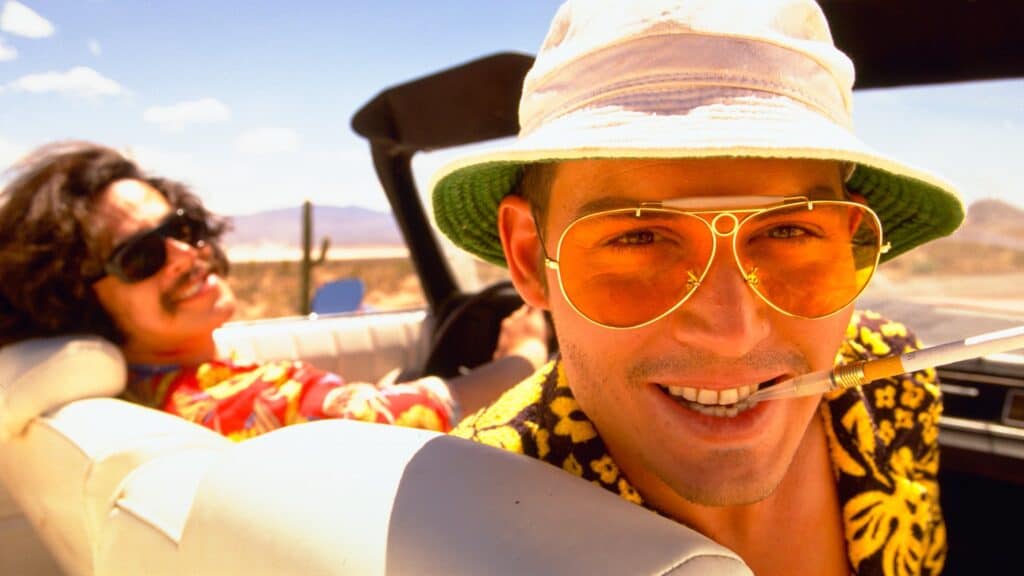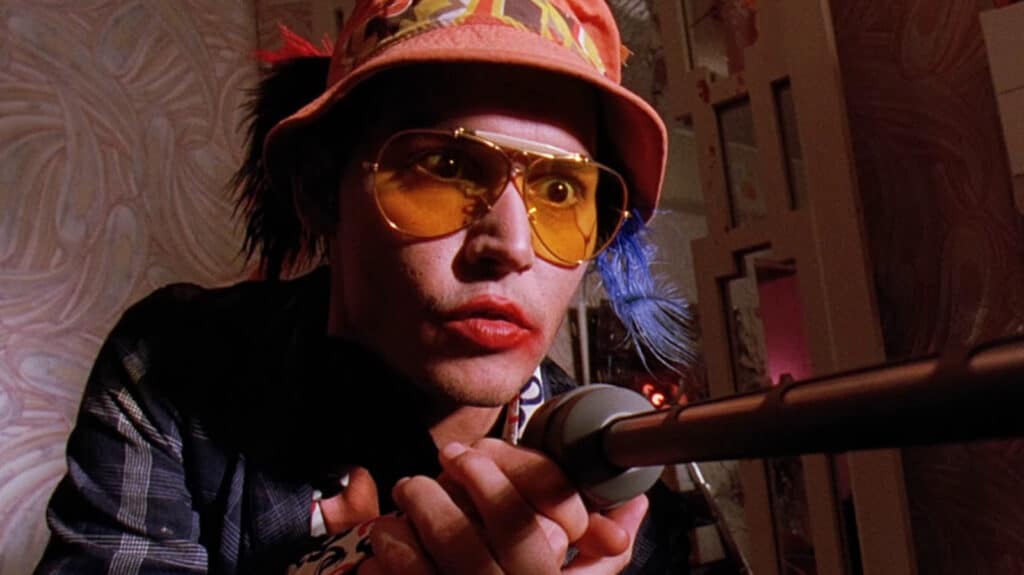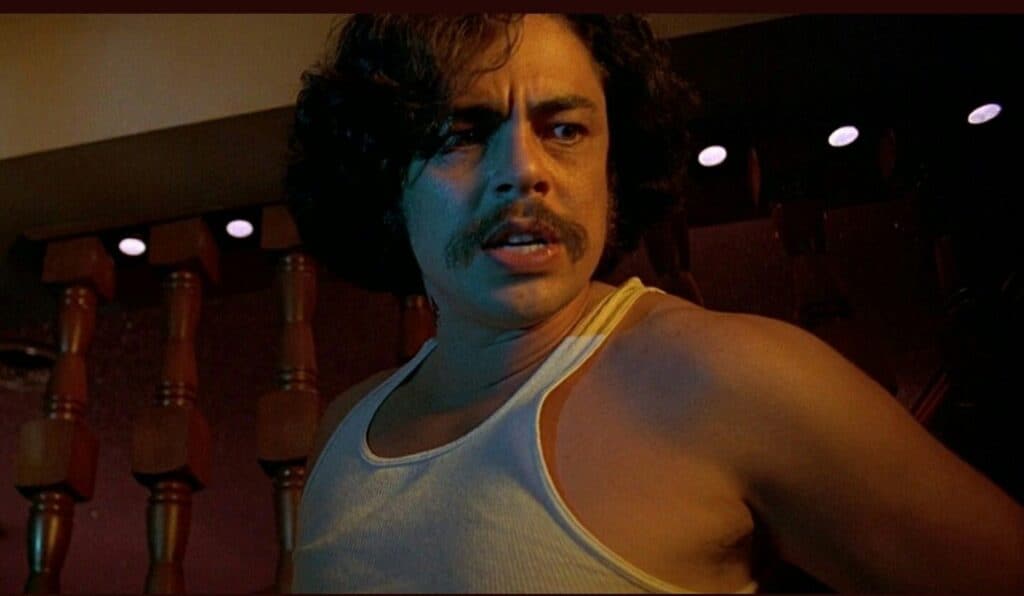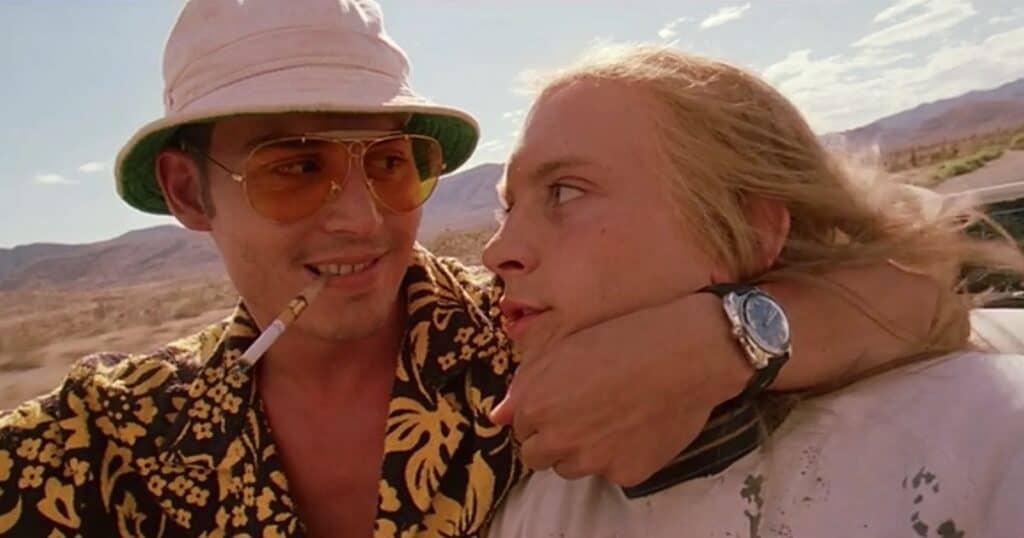
They say “sex sells” in Hollywood, right? But what about drugs? After all, once the production code was lifted, successful counterculture drug movies like Easy Rider gave way to the indie auteur movement in American cinema in the 1960s and 70s, where Hollywood renegades like Brian De Palma and Martin Scorsese picked up the mantle and went on to make all-time classics like Scarface and Goodfellas decades later. In the interim, there has been no shortage of critical and commercial drug movie successes, be they Blow, Sicario, Traffic, The Wolf of Wall Street, you name it.
So then, WTF Happened to Fear and Loathing in Las Vegas? Seriously. How does such an authentic movie from the altered mindstate of Gonzo journalist Hunter S. Thompson, one directed by the venerated filmmaker Terry Gilliam and featuring unforgettable performances by Johnny Depp and Benicio Del Toro… how does a movie like that stumble at the box office and be considered a disappointing flop? More to the point, how does a movie like Fear and Loathing in Las Vegas overcome its financial failures at the time, find its like-minded audience of tripped-out counterculture rebels, and become a bona fide cult classic 25 years later? Well, we’re about to find out when we break this sucker down and figure out through the movie’s rocky production history… WTF Happened to Fear and Loathing in Las Vegas?!?
Speaking of Scorsese, believe it or not, he was one of the first Hollywood directors that attempted to translate Fear and Loathing in Las Vegas to the silver screen (via Wide Angle Close Up). Scorsese was interested in directing a script written by famed author Larry McMurtry in 1976, who adapted Hunter S. Thompson’s 1971 source novel (via Texas Monthly). At the time, Oliver Stone, and artist Ralph Bakshi were also interested in directing the film. But like Scorsese, both Stone and Bakshi had trouble finding producers interested in making the project. Bakshi even wanted to turn the novel into an animated film.
After languishing for roughly 15 years, Rhino Films began working on a big-screen adaptation of Thompson’s novel as early as 1992 (via Premiere). Around that time, both the Head of Production at Rhino Films and producer Stephen Nemeth wanted unproven director Lee Tamahori to helm the project. However, Tamahori was unavailable until the end of 1997. Johnny Depp, who had already been cast as Duke, lobbied for Bruce Robinson to direct the film based on the strength of his acclaimed 1987 feature Withnail & I. Robinson was “unavailable by choice” following the offer (via Collider), indicating his lack of interest in the controversial subject matter. Ironically, Robinson did direct Depp in The Rum Diary in 2011, in which the actor also portrays a version of Hunter S. Thompson.
With the legal rights to Thompson’s novel set to lapse, Rhino Films asked the author for an extension, but he declined. In a panic, Rhino hastily green-lit Fear and Loathing and Las Vegas and slated Alex Cox (Repo Man) to direct the film within a few days. According to Nemeth, Cox was chosen because he “do it for a price, could do it quickly and could get this movie going in four months” (via Premiere). Here’s where things get interesting. Rhino Films hired Terry Gilliam to work on the film with Cox still on board to direct. As a result, Thompson extended Rhino Films the rights to his novel, but only agreed to do so if Gilliam directed the movie, not Cox. According to Thompson via Premiere: “They just kept asking for more [time]. I got kind of agitated about it because I thought they were trying to put off doing it. So I began to charge them more… I wanted to see the movie done, once it got started.”
Still favoring Cox as the director, Rhino Films was afraid that Gilliam wouldn’t work out and did not offer him a firm contract as a result. When Rhino threatened to make the movie with Cox at the helm without Depp and Del Toro in the lead roles, the actors became upset and used their clout to voice their displeasure to producer Laila Nabulsi. This ultimately prompted Universal to enter the fray and agree to distribute the film. Depp and Gilliam were paid $500,000 apiece to remain on board, despite Gilliam still not having a legit deal as the director. While all this may sound tedious, the craziest part is that once filming began, Depp and Gilliam vindictively had Rhino Films locked out of the set for the entire production. The rebellious nature only seemed to fuel the revolutionary nature of Thompson’s novel.
To his credit, Gilliam had been courted to direct Fear and Loathing in Las Vegas as early as 1989, three years before Rhino Films became involved. According to Gilliam via Wide Angle Close-Up: “I’d had two occasions before where a script was sent to me. One was about the end of 1989, and I thought, ‘Wow, it would be really good to usher in the ’90s with a film based on that book.’ But I got involved in Fisher King at that time. And the scripts I’d read, none really quite did the job. They start well because the book starts well, but in the second part the same problem always happens — and in a sense it happens in the book as well.”
In continuing his criticisms of the scripts he received for the film, Gilliam continues by saying: “The book itself just kind of peters out, it’s always to me been one of the problems with the book; it’s got a very weak ending. The earlier scripts just became boorish in the second half because the guys were just crashing around the place, there’s no substance to what they’re doing, and because it has to be a reaction to something, there have to be all these reflective elements that weren’t in there. I think that’s probably the thing that people have shied away from [in their adaptations].”
Cox and his collaborator Tod Davies wrote one of the early script drafts. During pre-production, Cox had a falling out with Nabulsi over creative differences. Nabulsi gave Rhino Films an ultimatum and forced the company to choose between her and Cox. However, Thompson hated the Cox/Davies script and inherently trusted Nabulsi as a producer. Nabulsi was Thompson’s former girlfriend and someone he knew since 1977 and who had been trying to make the film for over a decade. After choosing Nabulsi, Rhino Films fired Cox and gave him $60,000 in writer fees for his troubles. Yet due to an ugly, contentious legal fiasco with the Writers Guild of America (WGA), Gilliam and his co-writers could not remove Cox and Davies’ names from the final credits of the movie. To receive credit for himself and Grisoni, Gilliam torched his WGA card in public at a book signing on May 22, 1998, the same day the film was released in North American theaters. To fight the power, Gilliam ended his standing with the union.
Now back to Gilliam’s rewriting process, which he began at his home with the help of screenwriter Tony Grisoni in May 1997. When asked about the writing process by Wide Angle Close-Up, Gilliam candidly responded by saying: “Tony Grisoni had written for television, and he wrote a Jon Amiel movie, Queen of Hearts. We’ve been working on a couple of projects together for some time. When I decided to do Fear and Loathing, I called him up and asked him. And what was interesting was he knows Alex Cox, and when he had heard that Alex was going to direct it, he actually called Alex up and asked if he could co-write it with him. Alex was working with Tod Davies, so it never happened. So Tony got a second chance to write it.”
As a way to inject the manic energy of Thompson’s novel into the screenplay, Gilliam and Grisoni wasted very little time writing their adaptation. Gilliam continues, adding: “We wrote it in 8 days, and then we read it, and I didn’t like it. So we re-wrote it in two days. A lot more work happened through the course of rehearsals and everything — we were constantly writing, rewriting bits, changing, but the basic idea was to work very fast. I think we made the right choice because if you take too long at it, you just get depressed because there’s so much in the book you’re leaving out.”

One scene Gilliam was intent on not leaving out was Duke and Gonzo’s ugly confrontation with the North Star Cafe waitress (Ellen Barkin) at the end of the film. According to The New Yorker, Gilliam claimed: “This is two guys who have gone beyond the pale, this is unforgivable – that scene, it’s ugly. My approach, rather than to throw it out, was to make that scene the low point.”
When the studio originally wanted Gilliam to give the movie a modern spin by setting it in the 1990s, the director dug in and remained steadfast in his beliefs that it needed to be set in 1971 like the novel. According to the AP, Gilliam’s response to the request was: “I looked at the film and said, ‘No, that’s apologizing. I don’t want to apologize for this thing. It is what it is.’ It’s an artifact. If it’s an accurate representation of that book, which I thought was an accurate representation of a particular time and place and people.”
As alluded to, the writing process for Fear and Loathing in Las Vegas continued well after the casting process took place. It’s worth noting that back in the 70s when Scorsese was interested in making the film, he wanted Jack Nicholson and Marlon Brando to play the roles of Raoul Duke of Dr. Gonzo, (via The New York Times), which would have been all kinds of badass. Alas, once Nicholson and Brando were deemed too old to play the parts, SNL alums Dan Aykroyd and John Belushi were considered for the roles. However, once Belushi died in a tragic drug overdose of all things, that idea expired as well. According to Nabulsi via the DVD commentary for the film, John Malkovich was later in the running to play Duke, but he too eventually past his prime before production took off. Finally, Thompson’s personal friend John Cusack was almost cast as Duke based on the strength of previously directing a stage play of Fear and Loathing in Las Vegas with his brother playing the lead role. In the end, once Thompson met Johnny Depp, he instantly met a kindred spirit and lifelong soul mate and genuinely felt that nobody else could credibly portray himself on screen (via Premiere).
Once Depp was cast as Duke, the actor began a rigorous preparation process to put himself in Thompson’s shoes and portray the character as authentically as possible. According to Johnny, Get Your Gun by Douglas Brinkley, Depp became so invested in the role that, in the spring of 1997, he moved in with Thompson at his Owl Farm in Colorado and lived in his basement for four months. Depp and Thompson became incredibly close during this period, in which Depp studied Thompson like a hawk and learned all of his speech patterns, rhythms, vocal inflections, physical mannerisms, and personal affectations. Aside from the personal peccadilloes, Depp also gained access to Thompson’s original manuscript for Fear and Loathing in Las Vegas, as well as detailed notes, relics, and mementos that further shed insight into how to portray Duke onscreen. Depp told Elle Magazine, “he saved it all. Not only is the book true, but there’s more. And it was worse!”
During his four-month stay in Thompson’s basement, the two men bonded in all types of weird ways that helped inform Depp’s performance. For instance, Depp allowed Thompson to shave his head in the kitchen using the spotlight from a miner’s hardhat. The two also swapped cars, with Depp tooling around California in the same 1971 red convertible Chevrolet Caprice, aka The Great Red Shark, that appears in the movie. In fact, almost all of the flashy 70s-style regalia Depp sports in the film actually belonged to Thompson. Depp also used such personal items as bucket hats, Hawaiian shirts, a driver’s license, a press pass, a makeshift jacket, a silver medallion, and Thompson’s token cigarette filter to authentically recreate Duke’s persona in the film. Interestingly enough, Depp’s Ed Wood costar Bill Murray, who famously played Duke in Where the Buffalo Roam in 1980, called Depp prior to filming and told the actor (via Road to Ruin by Brinkley): “Be careful, or you’ll find yourself ten years from now still doing him…Make sure your next role is some drastically different guy.”
Not for nothing, Depp went on to play Dean Corso in The Ninth Gate next, which could not be more different than Duke.
As for the role of Duke’s lawyer Dr. Gonzo, the character is based on Thompson’s longtime friend Oscar Zeta Acosta, who reportedly vanished in 1974. When Benicio Del Toro was cast in the role, he also underwent extensive preparation to transform his appearance. According to The Guardian, Del Toro gained more than 45 pounds in nine weeks prior to filming by eating as many as 16 donuts a day. What a life. Del Toro also spent time vigorously researching Acosta’s life prior to filming.
Principal photography on Fear and Loathing in Las Vegas began on August 3, 1997. According to Gilliam via The Globe and Mail, production did not have a firm budget when filming commenced. However, the final figures are estimated at about $18.5 million. Gilliam felt that he never had full support from the studio, claiming, “Certain people didn’t… I’m not going to name names but it was a strange film…like one leg was shorter than the other. There was all sorts of chaos” (via Cardboard Castles and Chaos by David Gale).
Filming took place on location throughout Las Vegas and surrounding areas in Nevada as well as California and Arizona. Given the controversial subject matter, Gilliam ran into a slew of production problems relating to Casino access. According to Gale, production was only allowed to film inside the casinos from 2 to 6 AM and was only provided six gaming tables to use for extras to crowd around. Worse yet, the casinos insisted the extras gamble while present at the casinos. According to Gilliam via Wide Angle Close-Up: “Yeah, that was the problem. Cooperating with our vision wouldn’t gain the hotels much! We ended up with a couple of the old hotels who for whatever reason were at least accommodating enough to let us shoot there. We were only able to shoot inside the Riviera and inside the Binions. The Riviera was actually very accommodating. And as far as exteriors, the Palace Hotel we converted into Bazooka Circus. We had to wheel in this 20-foot-high clown head which is a huge open mouth as our entrance.”
He continued by adding: “Then they’d got six lanes of car in the entranceways for cars to come in and disgorge the clients, and we were allowed to use two lanes at any one time. So we were dancing around a casino that was functioning. And so that was all very difficult stuff. And each thing we had to get done in a night; we were not allowed to come back anywhere!”

The Bazooko Circus Casino where Duke and Gonzo stay in the film was modeled after the real Circus Circus Casino in Las Vegas, which is referenced in the book. When Circus Circus refused Gilliam the authority to film there and remove all mention of its name in the movie, the director made sure to poke fun at the gaming parlor by recreating the clown mascot on the exterior with a rainbow mallet instead of a pinwheel and Merry-Go-Round bar in the interior that circulates in the opposite direction as the real Circus Circus. As for the giant Bazooko gorilla statue adorning the front of the Casino in the film, it now “lives” in Johnny Depp’s front yard after the actor kept the prop as a memento.
According to American Cinematographer, exterior shots of the Bazooko Casino were filmed outside the Stardust Casino. Interiors were partially filmed at the now-defunct Boardwalk Casino in Las Vegas as well as on a Warner Bros. soundstage in Los Angeles.
One of the biggest challenges during production was recreating the look, feel, and vibe of 1970s Las Vegas as well as the surreal drugged-out hallucinatory tableau that defined Thompson’s work. Gilliam hired cinematographer Nicola Pecorini to help him establish the distinct visual quality. Part of their process entailed using rear-projection footage from the 1978 TV show Vega$, which increased the “already otherworldly tone an extra notch” according to Pecorini.
Indeed, a deliberate effort was made by Gilliam to reflect the zany gonzo energy of the novel by practicing gonzo, guerilla-style filmmaking on the fly to capture the essence of the 1970s zeitgeist Thompson was speaking to. According to Pecorini, the film’s trippy visual aesthetic was inspired by Robert Yarber’s paintings, which are, “very hallucinatory: the paintings use all kinds of neon colors, and the light sources don’t necessarily make sense.” Gilliam expounds on this decision, adding that they used the Yarber paintings, “While mixing our palette of deeply disturbing fluorescent colors.”
To achieve the saturated look of the hypnotic neon colors the final film has, Gilliam initially wanted to use a wide-angle anamorphic lens. However, when it proved too costly, he and Pecorini compromised by combining an Arriflex 535, Arri BL-4S, and the Arri 35-iii with a set of Zeiss Standard Primes and Kodak’s 250D Vision 5246 filmstock (via The ASC).
From the onset, it was always Gilliam’s intention to make the audience feel as if they were experiencing a vicarious drug trip while watching the movie. According to Fear and Loathing. Loaded, Gilliam stated: “We start out at full speed and it’s WOOOO! The drug kicks in and you’re on speed! Whoah! You get the buzz – it’s crazy, it’s outrageous, the carpet’s moving and everybody’s laughing and having a great time. But then, ever so slowly, the walls start closing in and it’s like you’re never going to get out of this fucking place. It’s an ugly nightmare and there’s no escape.”
One of the movie’s most memorable scenes comes when Duke and Gonzo arrive in Vegas and begin hallucinating a gory reptilian orgy in the bar lounge. The production originally planned for 25 full-scale animatronics to use in the scene, but they were only provided with seven or eight. To atone for this, the crew utilized motion control methods to make it appear as if the entire room was invaded by the horny slavering lizards. They even redressed the same lizards multiple times and had them pass the camera to achieve the effect.
Furthermore, Gilliam and Pecorini devised specific “drug phases” to recreate cinematically to make each substance feel slightly different. For instance, when Duke huffs ether, Pecorino describes using a hazy, “loose depth of field” where “everything becomes non-defined.” To simulate the effects of the fictional narcotic Adrenochrome, which Thompson made up for the book, Pecorini used a visual effect that made “everything get narrow and claustrophobic, move closer with lens.”
When simulating the symptoms of mescalin, the idea was to have “colors melt into each other” by using “flares with no sources” and “playing with color temperatures.” As for the amyl nitrate Duke and Gonzo snort in the film, Pecorini noted that the “perception of light gets very uneven, light levels increase and decrease during the shots.” Finally, for the feeling of LSD, Pecorini was sure to film “everything extremely wide” and create disorienting “hallucinations via morphs, shapes, colors, and sound.”
When it came to filming the desert scenes and the Mint 400 Motorcycle Race in Vegas, Pecorini sought to create an endless vista by erasing the horizon line, which he thought would emphasize “A certain kind of unreality outside the characters’ car, because everything that matters to them is within the Red Shark.”
Speaking of the desert scene, Gilliam makes a cameo as a reporter wearing a hat and holding a microphone as the racers take off. The sequence was meant to take place at dawn, but according to Gilliam on the Criterion Collection DVD commentary, they had set up the shot and timed it perfectly with the rising sun. But when Depp went to start the car, nothing happened. After realizing nobody had filled the tank with gas, the shot had to be rescheduled for a different part of the day. This is why, if you look closer, the scene is much too bright to be dawn.

Another visual inconsistency comes toward the beginning when Duke and Gonzo pick up the hitchhiker played by Tobey Maguire, whose hair changes drastically in the scene. According to Gilliam, they had to reshoot the sequence months later and were unable to convince Magure to shave his head and wear the wig. To do so would have cost $15,000 as stipulated by Maguire’s contract, and since the budget was already spiraling out of control, the production could not afford it. Ironically, in the end, they spent much more than $15,000 to use a bald cap and make-up FX, and digitally remove the hitchhiker’s hairline from the final film. Magure also wears a t-shirt with a picture of Ralph Steadman, Thompson’s longtime artistic collaborator who did the original illustrations for the novel. On a trivial note for movie Easter egg hunters, Steadman also created a sickly-looking cactus that appears in the background throughout the film, beginning with a shot in the desert when Duke pulls over after hallucinating bats. According to Gilliam, he grew tired of dragging that damn cactus all over the place during production.
An additional visual sight gag includes the iconic Gonzo Fist symbol, which can be seen drawn with shaving cream in the hotel bathroom when Dr. Gonzo has a bath. The Gonzo Fist is also seen crushing a peyote button on a political poster in Gonzo’s office, which is a real poster from the time Thompson ran on the Freak Power party ticket in Colorado in the 1970s. Other random factoids include Ellen Barken wearing a prosthetic ass for her role as the waitress, and Del Toro improvising licking the cocaine from his suitcase after he spills it in the car. Meanwhile, Gary Busey, who plays the sheriff, improvised the hilarious “Give Me a Kiss” line while working one day on the movie. The gesture reportedly mortified Thompson and producers, but Gilliam thought it was funny and kept it in the final film.
After 56 days of shooting, principal photography on Fear and Loathing in Las Vegas officially wrapped on October 22, 1997. With exactly seven months until the film was slated for theatrical release, Gilliam had no choice but to subject the film to test screenings, something the director loathed. Gilliam admitted to Elle, “I always get very tense in those (test screenings), because I’m ready to fight. I know the pressure from the studio is, ‘somebody didn’t like that, change it!’” Far more interested in making sure Thompson enjoyed the movie than test audiences, Gilliam was most proud when Thompson reacted viscerally to his first time seeing the finished film.
According to Neon Magazine, Thompson did enjoy the film, saying, “Yeah, I liked it. It’s not my show, but I appreciated it. Depp did a hell of a job. His narration is what really held the film together, I think. If you hadn’t had that, it would have just been a series of wild scenes.” Thompson did take umbrage, however, with the scene in which Duke callously tosses change at the dwarf waiter, claiming it was untoward and inaccurate to his character.
Alas, despite the prevailing wisdom that drugs sell just as efficiently as sex in Hollywood, Fear and Loathing in Las Vegas proved to be too much of a hallucinatory nightmare to resonate at the box office. The movie opened in theaters on May 22, 1998, earning a paltry $10.6 million in worldwide ticket sales, barely enough to justify half of its $18.5 million budget. Gilliam’s intention to give audiences a vivid and vicarious drugged-out thrill ride turned out to be too hardcore and alienated both critics and moviegoers at the time. Only years later, in retrospect, did the film begin to gradually grow in popularity and eventually become a bona fide cult classic recognized for its high replay value and eminently quotable moments.
And that’s kinda what the f*ck happened to Fear and Loathing In Las Vegas! Terry Gilliam boarded the project at the zero hour, hastily penned a script in roughly one week, and went through a grueling legal battle to retain a screenplay credit, which resulted in him burning his WGA card and resigning from the union. If that wasn’t trying enough, Gilliam had Rhino Films barred from the set before experiencing a host of problems during principal photography, not least of which was the uncooperative Casinos that denied filming access. And yet, the harried production managed to imbue Gilliam with the manic energy necessary to capture the essence of Thompson’s novel perfectly. In the end, while the movie proved to be too far out for audiences of the late 90s, like the source novel, Fear and Loathing in Las Vegas has only become more appreciated over time. Gilliam is proud of it. Depp and Del Toro are proud of it. Most importantly, Hunter S. Thompson approved of the film before his death. Who cares if his drug story didn’t sell in Hollywood at the time; hard-hitting substances influence the masses eventually!
Originally published at https://www.joblo.com/wtf-happened-to-fear-and-loathing-in-las-vegas/


